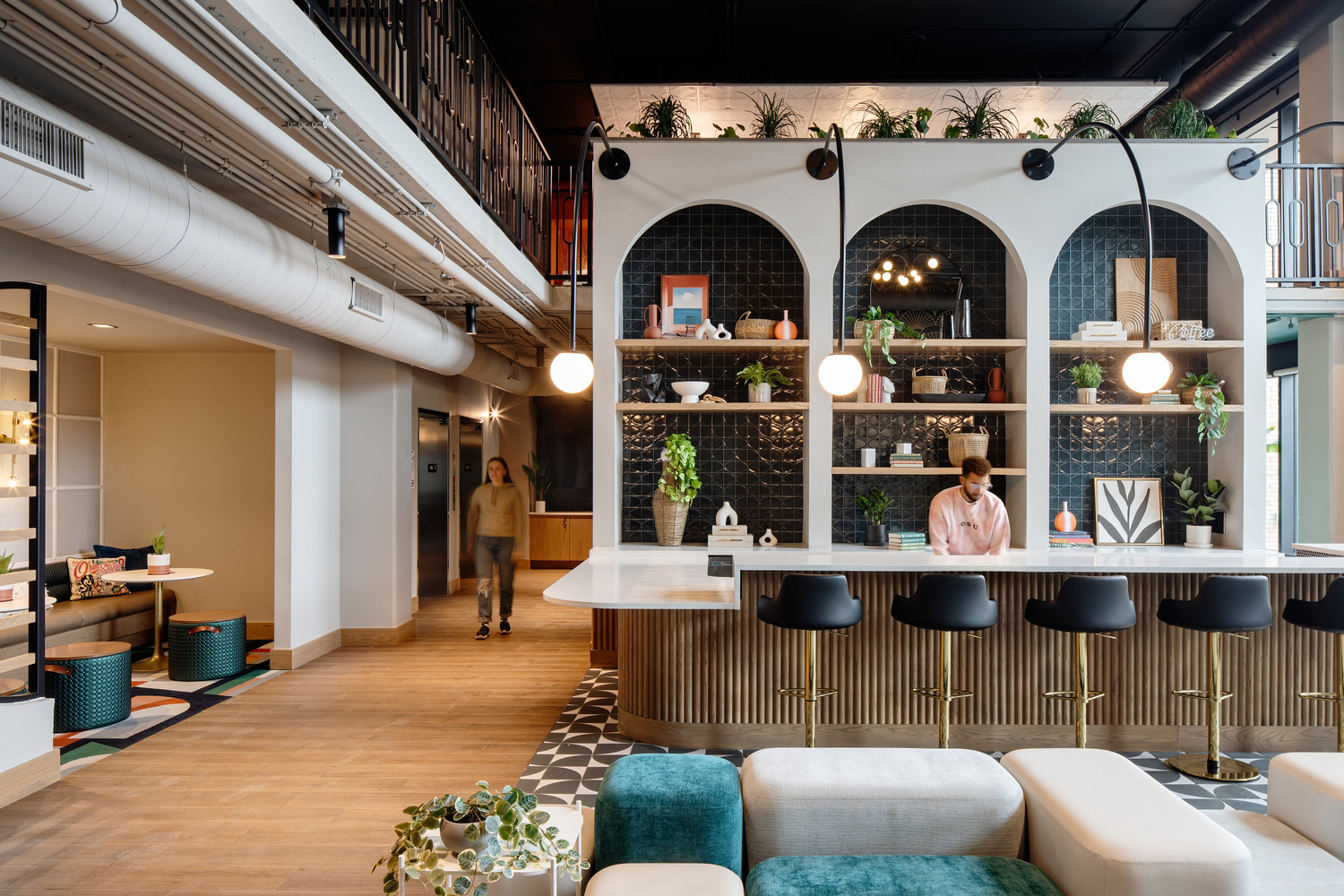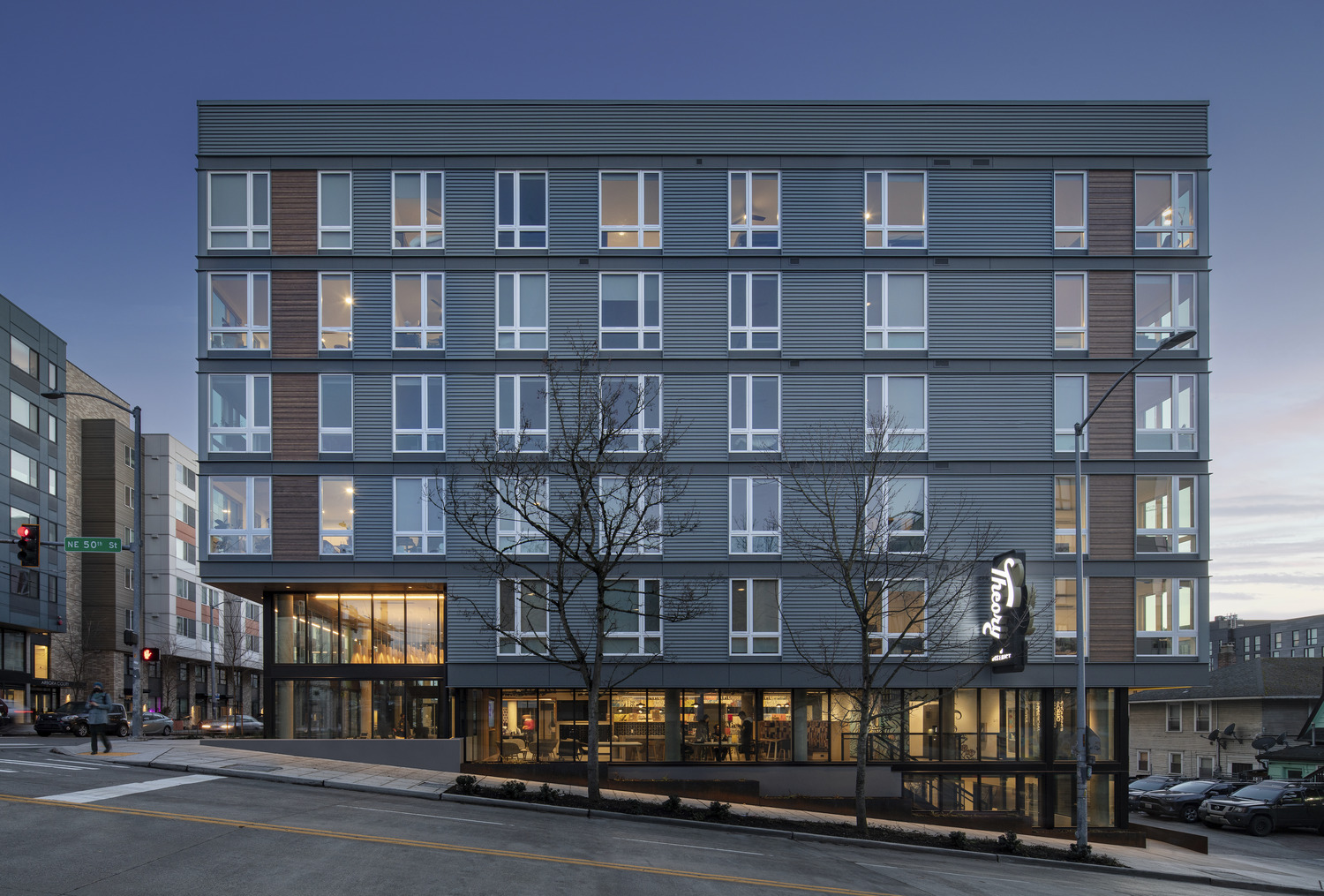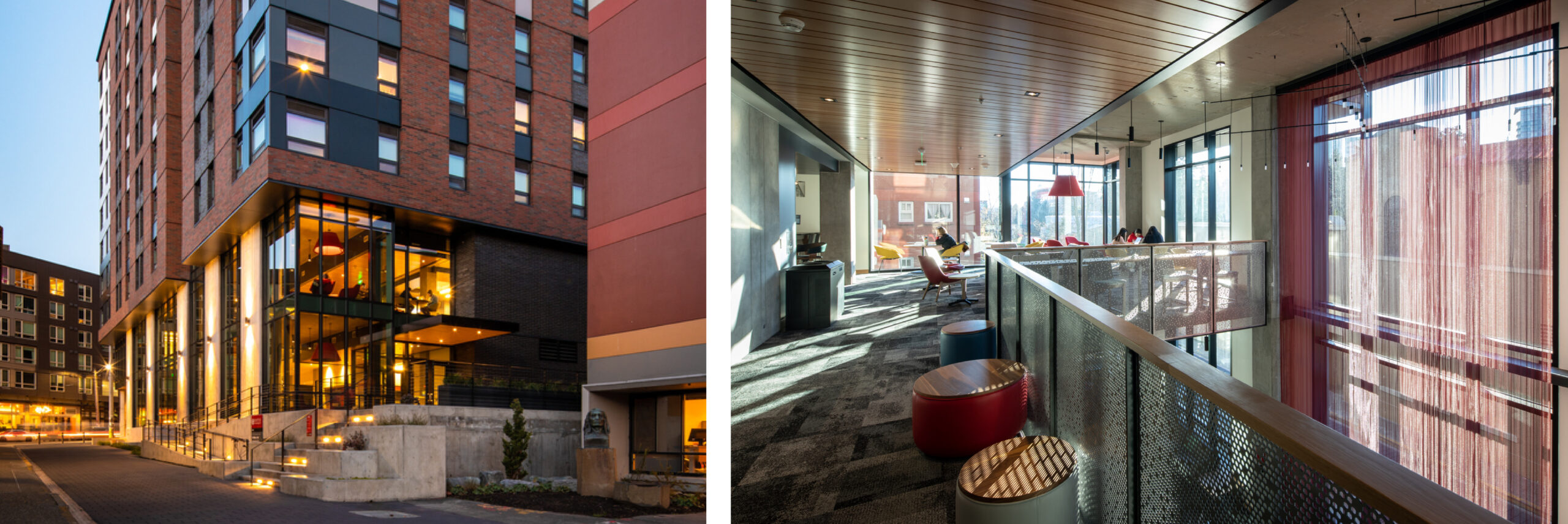As student populations grow and on-campus housing remains limited, off-campus housing has become a critical part of the higher education experience. According to Propmodo, the demand for student housing greatly exceeds supply at many universities, making the asset class an unlikely real estate kingmaker over the past two decades. But this growing reliance has brought on new challenges.
While the first-year dorm experience is often rich in social interaction and university programming, the transition off campus can come with a steep decline in connection, support, and engagement. A column in The Daily Gamecock, the University of South Carolina’s student newspaper, put it plainly: “Off-campus housing can be isolating.” When students move off campus, they risk losing the daily rhythms and casual relationships that make college life feel cohesive. This raises a fundamental question for developers and designers alike: How can we ensure off-campus housing supports, not undermines, a student’s experience and well-being?
Putting Connection First in Off-Campus Housing Design
The best off-campus housing doesn’t just provide a place to live, it creates the conditions for connection. At VERVE West Lafayette, developed by Subtext near Purdue University, that philosophy takes center stage. Every detail of the building reflects Subtext’s broader “Unlonely Mission,” a commitment visible across other recent developments in Bloomington, Boise, and Columbus. All elements of the project are shaped by a singular mission: to unlonely student life. This shows up not just in the operations, but in the physical spaces themselves.
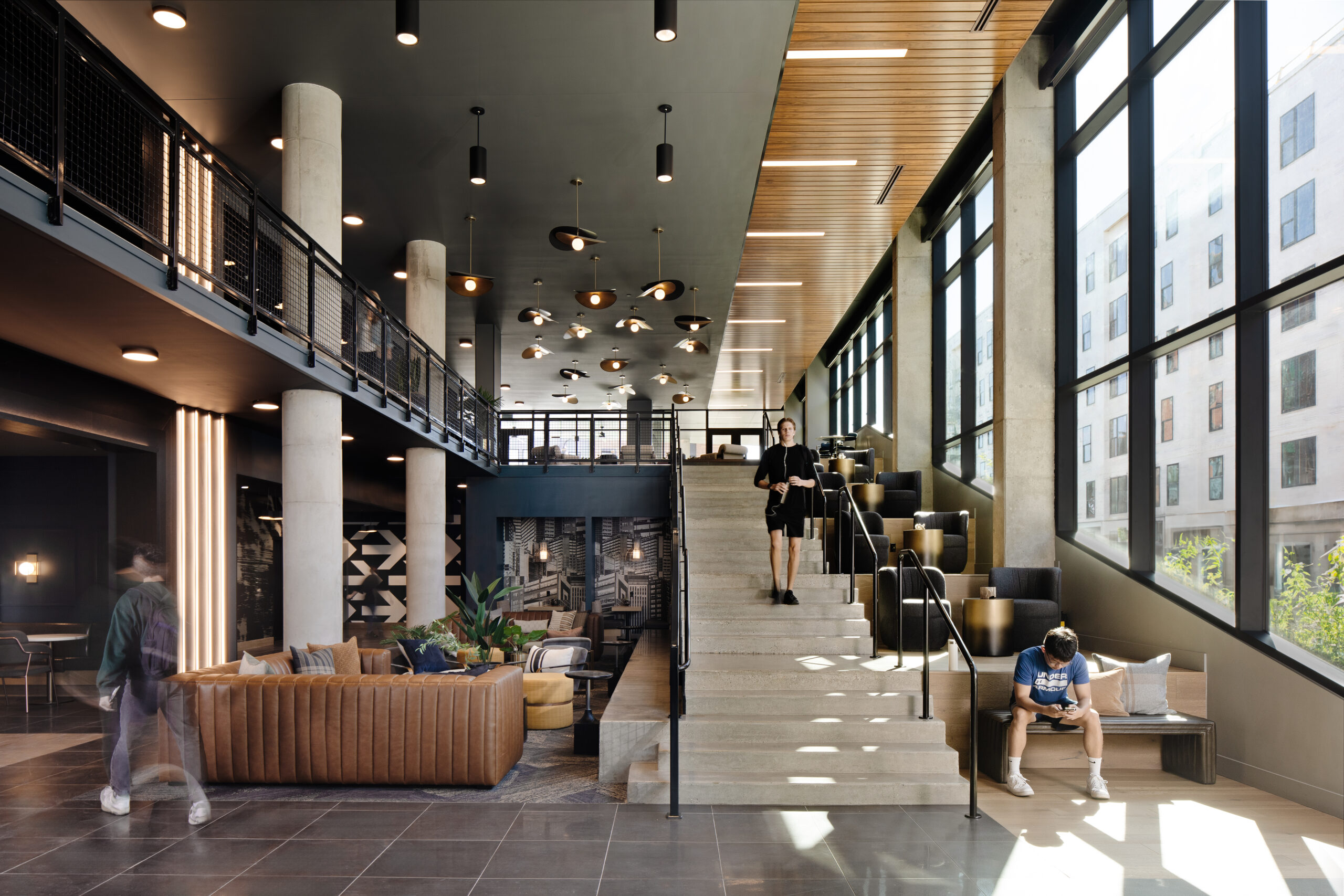
Verve West Lafayette
From the moment residents arrive, they’re greeted by a friendly team member at a vibrant leasing bar that doubles as a coffee spot by day and transforms into a social lounge by night. Upstairs, amenities include wellness-forward features like a yoga studio, sauna, and meditation spaces that prioritize mental health without feeling clinical. A bold design move, like a swirling slide connecting two floors, adds a touch of playfulness and sparks spontaneous interaction among residents.
There’s also an intentional balance between private and public. Study pods provide a quiet retreat, while common areas offer room for collaboration and friendship. Local design cues, from materials to murals, tie the space to the community to help students feel rooted in both place and purpose. And with a walkable location just minutes from Purdue’s campus, VERVE keeps students close to the heart of university life, even when they live beyond its footprint.
Design Strategies to Build Belonging Off-Campus
Creating a sense of belonging is essential for student success and well-being, especially in off-campus housing where students can feel socially and physically disconnected. Design plays a pivotal role in bridging this gap by encouraging interaction and fostering inclusive communities. Layered communal spaces like study lounges, community kitchens, maker spaces, fitness areas, and rooftop terraces support both structured and sporadic engagement. Semi-private “threshold” areas, such as shared entryways, floor lounges, or front porches, can facilitate passive interactions and foster the formation of micro-communities.
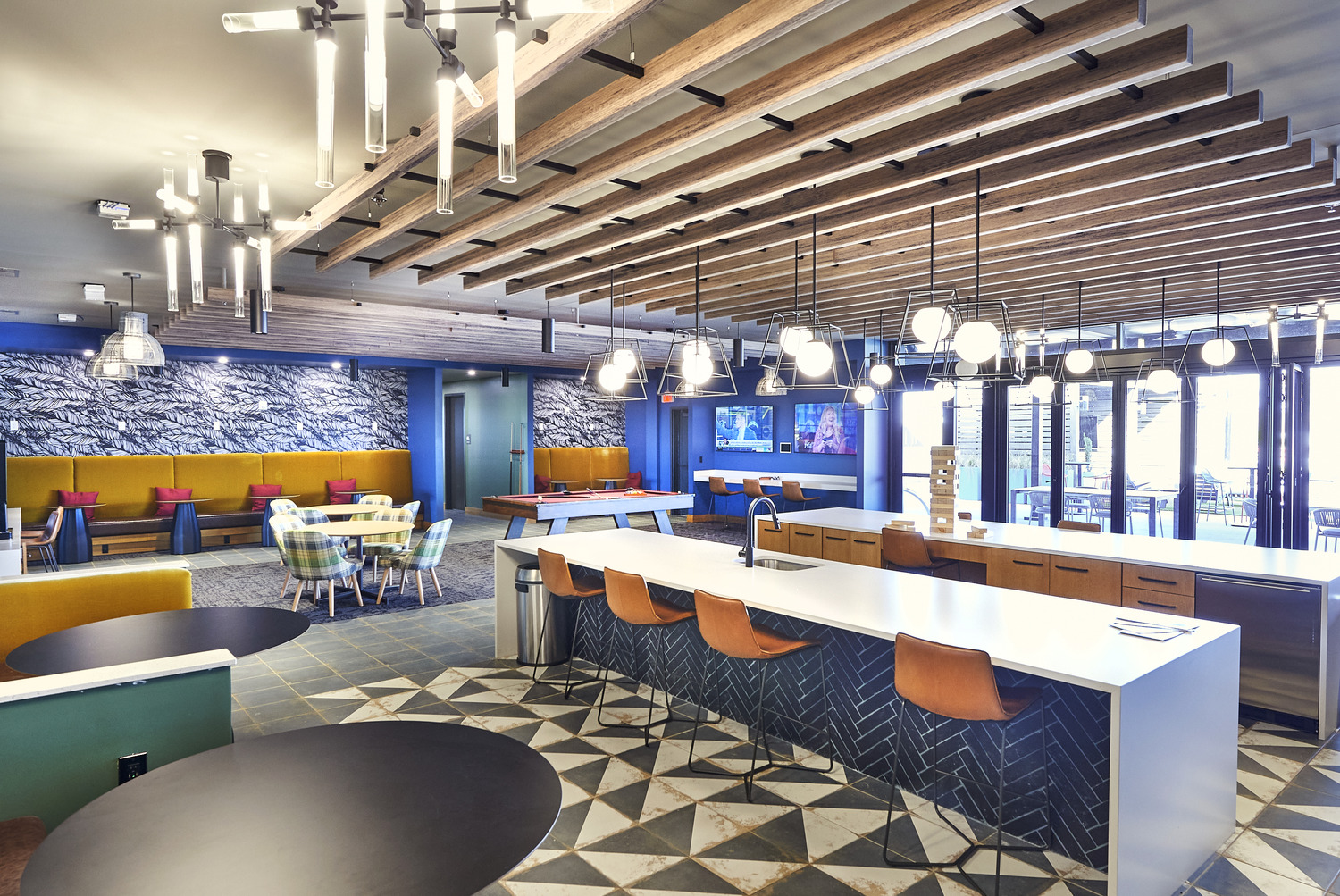
Verve Bloomington
Attention to scale and proximity is also essential. Breaking down large buildings into smaller “neighborhoods,” for instance, clusters of units sharing a lounge or “pods” with common amenities, helps cultivate a more intimate residential experience. Circulation spaces should be designed to encourage visibility and activity through features like open stairwells, transparent walls, and generous natural light.
Additionally, inclusion must be embedded from the start. Universal design features, like all-gender restrooms, multi-faith meditation rooms, and accessible layouts, signal that every student is welcome. But belonging also comes from the process. Early engagement through participatory design workshops, such as collaborative charrettes that use storyboarding, spatial mapping, or card-sorting exercises, can reveal latent needs and values.
Beyond the initial phases, ongoing feedback loops, through student advisory panels or milestone surveys, ensure that evolving expectations are acknowledged. Post-occupancy evaluations offer valuable insight into what worked, what didn’t, and what students wish had been included, providing direction for future projects. Partnerships with Student Affairs can surface less-visible insights, especially for underrepresented grounds, and collaborating with departments such as housing, DEI offices, or cultural centers helps ensure the design reflects the full spectrum of student experiences.
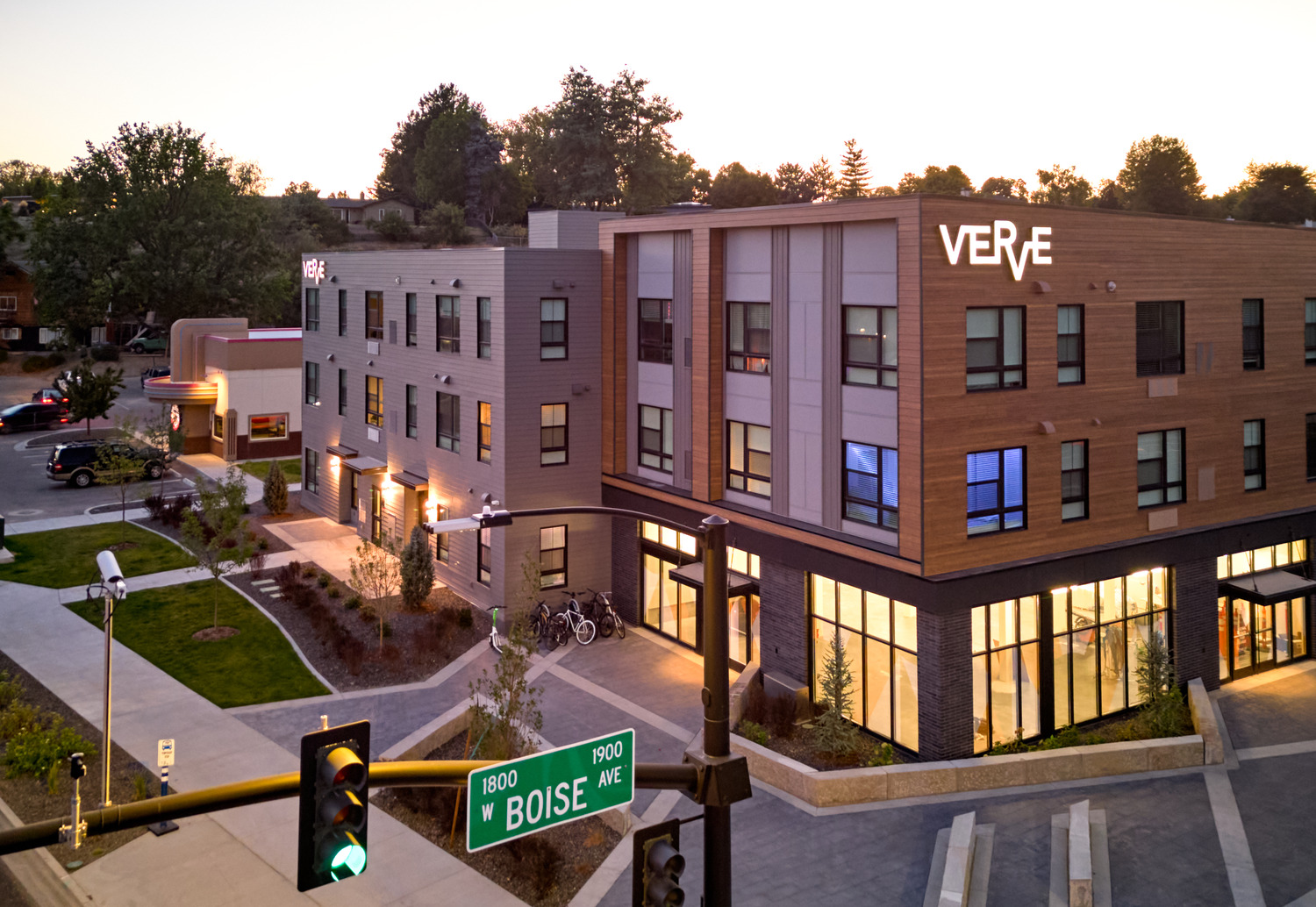
Verve Boise
The building’s location and its access to campus and neighborhood matter just as much. Well-lit walking paths, secure bike infrastructure, and proximity to transit support easy movement, while ground-floor retail or community-facing programming can integrate student housing into the fabric of the neighborhood. Visual and programmatic links to campus, views of landmarks, spaces for student orgs, and campus-branded graphics reinforce psychological connectivity. Ultimately, off-campus housing that offers informal third spaces, integrates wellness through design, and supports events like shared meals or club meetings becomes more than a place to live – it becomes a platform for unity, identity, and student growth.
A Call to Align
For the growing number of students living off campus, the line between inclusion and isolation often comes down to how their housing is designed. Developers, designers, and campus leaders must work together to meet students where they are, both physically, socially, and emotionally.
Off-campus doesn’t have to mean disconnected. In fact, with intentional design, it can be a powerful extension of campus life. By aligning priorities and centering connection, we can ensure that student housing continues to support, not interrupt, a student’s college journey.
Get to Know Our Student Housing Team
Our Higher Education designers share why they’re excited about the future of student housing – from rising global demand to an increasing desire for sustainable design – and what they enjoy most about their work.

Ankrom Moisan’s Student Housing Team (From left to right, starting in the back row: Jason Jones, Jenna Mogstad, Matt Janssen. Front row: Cindy Schaumberg, Alex Kuzmin, Mackenzie Snyder, Zach Stofferahn, Sydney Ellison)
Jenna Mogstad
4 Years
Associate Interior Designer
What do you like best about designing student housing?
I love it because it’s FUN. Student housing is invigorating and creative, with really unique requirements and programs to consider. Designing spaces that inspire and cater to young adults and users that are in such a formative stage of their life is really rewarding.
What has excited you about future work in this sector?
I’m most excited about incorporating trauma-informed design principals into student housing and higher education projects. Creating safe and non-triggering spaces for users from every possible background is something I take very seriously. We need to ensure that this population can thrive and be successful, for the future of us all.
What interesting changes have you seen in this sector over the years?
Since I graduated college in 2017, I’ve seen a big shift in the level of amenities that are provided in student housing. Each new project seems to just get better and better in terms of the activities and spaces that students are offered – right in their homes. Bars, theaters, spas, fitness, you name it. There’s a whole new level of approachable luxury that didn’t exist even just a short time ago when I was a student. It’s really exciting to see!
Mackenzie Snyder
1 Year
Interior Designer
What do you like best about designing student housing?
There are endless possibilities to be creative through finishes (fun colors, patterns, textures, etc.) and functions of a space (feature stairs with integrated seating, rock climbing walls and fun fitness zones, variations in study areas, etc.).
What has excited you about future work in this sector?
I like that this sector will always give us the opportunity to help create environments that help young students feel comfortable in the process of moving away from home and going through formative new steps in their life. The fact that design can help make that transition smooth is something that will never change, even as other trends do.
Is there anything that makes you uniquely suited to working in this sector?
I’m the youngest on the team and therefore the most recently out of college. I think because of that I can bring a unique perspective. I’m close to the current generation of students and can see firsthand how they tend to interact in their college environments. That can be very useful.
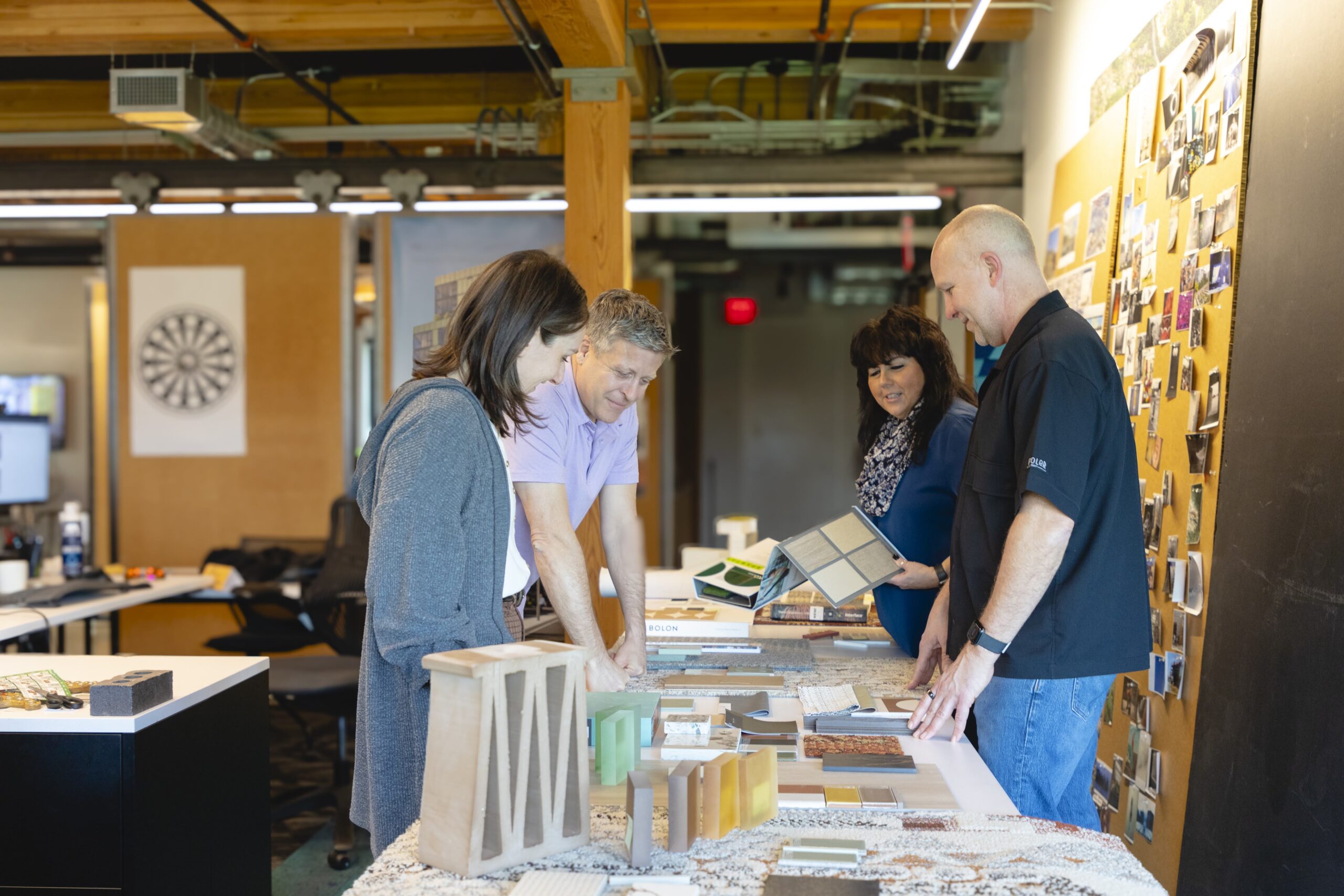
Sydney Ellison, Jason Jones, Cindy Schaumberg, and Matt Janssen at a design charette.
Zach Stofferahn
3 Years
Job Captain
What do you like best about designing student housing?
Student housing has a much bigger focus on communal spaces than a typical multi-family project.
What has excited you about future work in this sector?
I have seen several student surveys indicating sustainability is important to students today. We are always looking for ways to incorporate sustainable features into our buildings, so it is exciting to work with a user group that shares that value. I am hopeful that as students continue to seek those features, our design solutions can become more and more bullish on sustainability.
What’s uniquely challenging about designing student housing?
Schedule is important on all projects, but in student housing even more so because it is so critical to align building completion with the academic calendar. Pushing the schedule is typically not an option.
Sydney Ellison
6 Years
Interior Designer
What do you like best about designing student housing?
Getting to be very playful with our designs.
What has excited you about future work in this sector?
I’m excited by the increasing focus on mental health and wellness being integrated into off-campus housing.
What inspires you?
Our higher-ed team is inspiring; we have a great dynamic and collaborative environment.
Alex Kuzmin
3 Years
Technical Designer, Project Architect
What do you like best about designing student housing?
There are unique opportunities to be creative that don’t present themselves in other market sectors. I enjoy striking that delicate balance with budget and client expectations.
What has excited you about future work in this sector?
Rising global demand. With a projected 594 million higher education students by 2040, our studio is uniquely positioned to capitalize in this market sector with our experience and specialized knowledge base.
What’s uniquely challenging about designing student housing?
Designing student housing is uniquely challenging because you need to strike a balance when considering functional, flexible spaces with the design of an engaging, communal environment that supports both academic and social development.
Want to get to know the Higher Education Studio leaders? Hear from Cindy Schaumburg and Jason Jones here. Hear from Matt Janssen and Alissa Brandt here.
Get to Know (More of) Our Student Housing Leaders
Two of our Student Housing studio leaders, Jason Jones and Cindy Schaumberg, give us insight into what’s next for student housing (goodbye amenity wars!) and why they’re excited about it. They also share what makes each of them uniquely suited for this work; from college-aged kids to past careers.
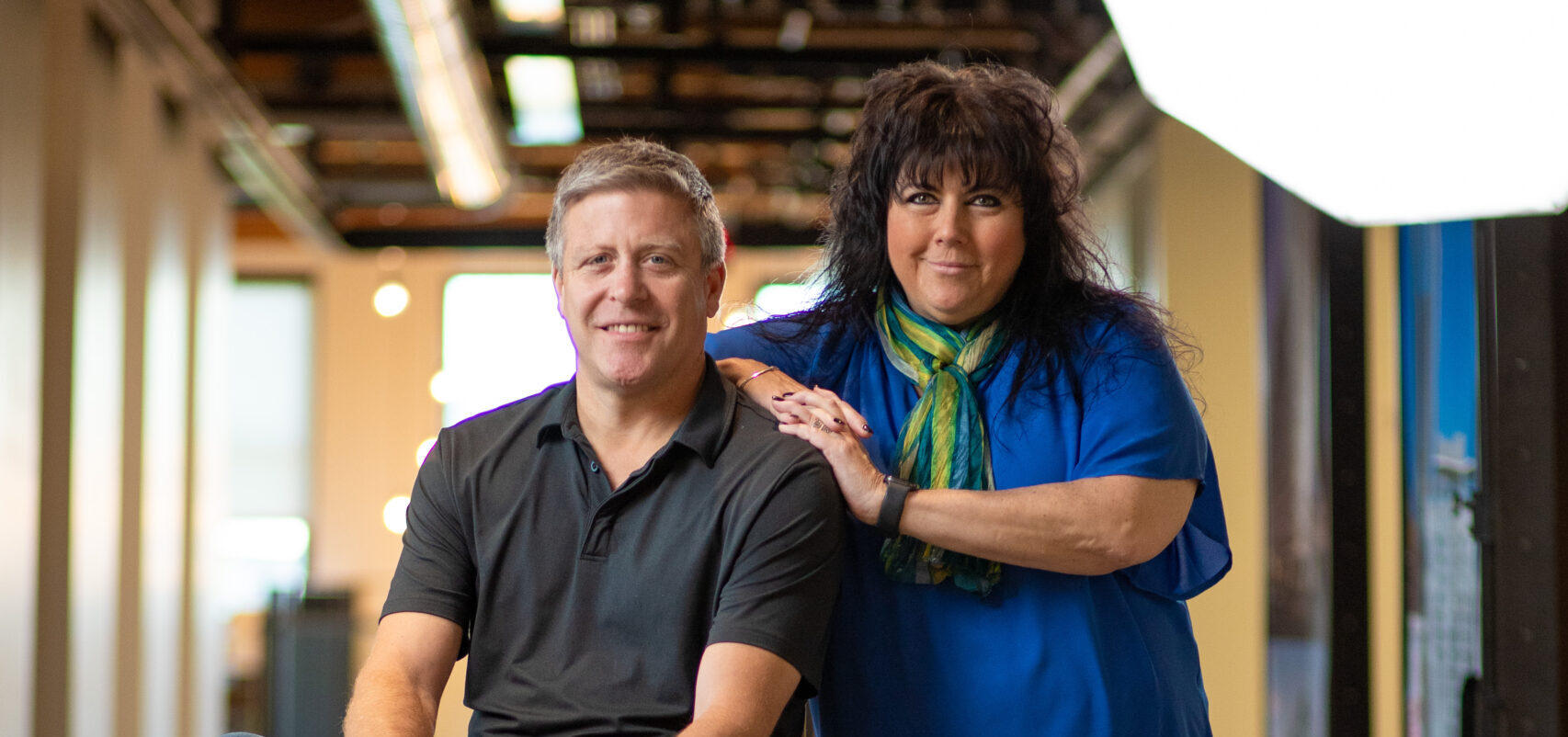
Cindy Schaumberg, Principal, Market Studio Lead
10 years of experience in student housing
Q: What do you like best about designing student housing?
A: I enjoy working on student housing because it allows me to contribute to the well-being and success of students. Providing a comfortable and safe living environment for students is incredibly rewarding. I love that thoughtful interior design can create a sense of community that will support students during their educational journey and make their time away from home enjoyable.
Q: What has excited you about future work in this studio?
A: There is a focus on creating inclusive and diverse communities within student housing. This involves designing spaces that foster a sense of belonging and respect for different cultures, backgrounds, and identities. By prioritizing diversity and inclusion, student housing can become a place where students feel supported, comfortable, and valued.
Additionally, with increasing awareness of environmental issues, sustainable design practices have become a top priority in student housing. Incorporating energy-efficient systems, using eco-friendly materials, and implementing recycling programs are some ways to promote sustainability in student housing.
Q: What’s uniquely challenging about designing student housing?
A: Students come from various backgrounds and have different needs and preferences when it comes to their living arrangements. Designing student housing that can cater to a wide range of preferences, from quiet study spaces to communal gathering areas, can be a challenge, but a challenge we feel is important to embrace.
Q: What inspires you?
A: My daughters! As a parent of two college-age daughters, I understand the delicate balance between providing support and fostering independence. This has made me more aware of the importance of fostering a sense of community and support within student housing. My daughters have given me firsthand experience and knowledge of their needs and preferences. I also have a better understanding of the amenities and features that are essential for a comfortable, productive and healthy living environment.
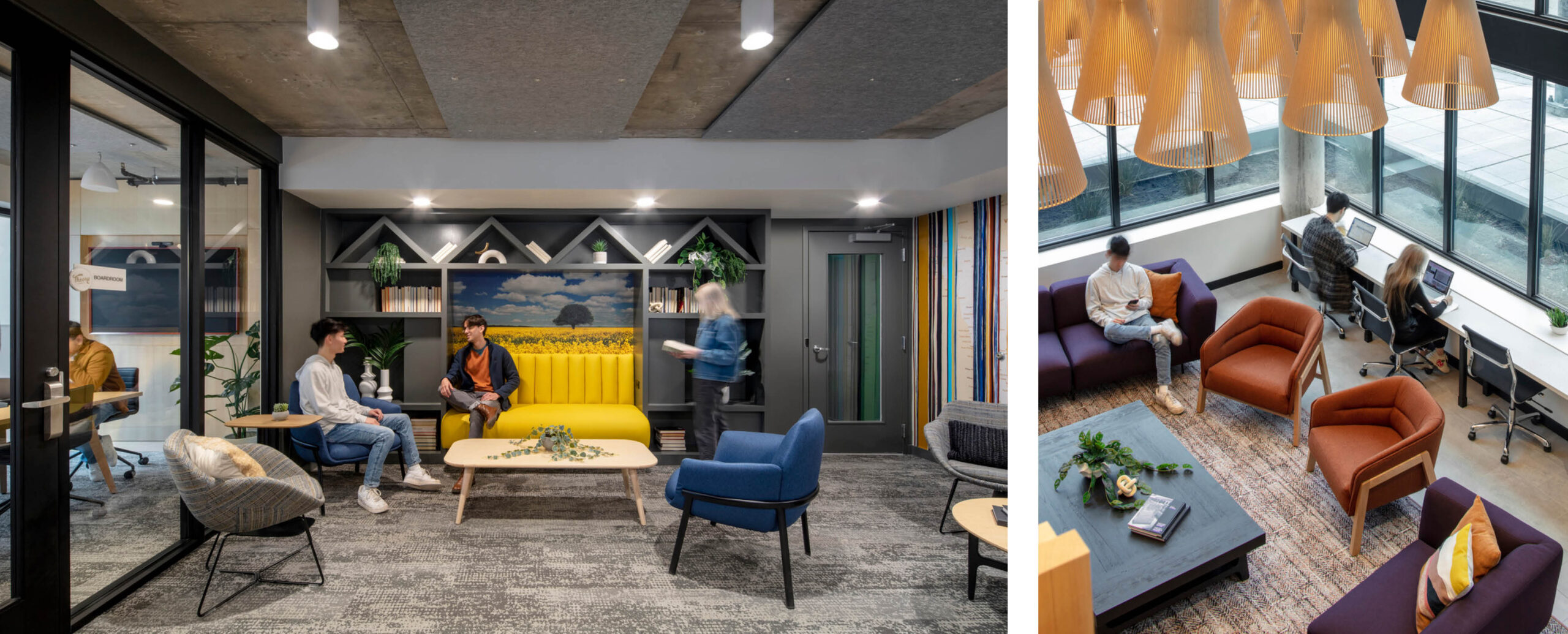
Theory U District
Jason Jones, Associate Principal
18 years of experience in student housing
Q: What do you like best about designing student housing?
A: For me, it’s all about the students and collaborating with like-minded individuals who share a passion for raising the bar in living and learning environments. I take great pride in knowing that I can contribute to positive change in students’ lives and their impact on society on our planet.
Q: What trends are you seeing in student housing?
A: I am excited to see a shift in our industry that is supporting affordable housing solutions that focus on mental, social, and physical wellness. Biophilia is an overused term these days, but it has a powerful impact on a human’s well-being.
Q: Is there anything that makes you uniquely suited to working in this studio?
A: My journey in this studio has been a unique blend of two professional lives—one as an architectural professional and the other as a development manager in student housing. These distinct roles have enriched my expertise and vision, allowing me to craft architectural concepts that seamlessly align with financial objectives while upholding the utmost quality. Quality and innovation are at the heart of my work, and I’m excited to keep pushing boundaries in this ever-evolving field.
Q: What’s a memorable career moment?
A: One of my first student housing projects was remodeling an old dining hall in a student housing complex. We had the opportunity to do some fun design work that we thought the students would love. The day it opened, I snuck in before the students came in and acted like I was going to school there so I could see what they had to say firsthand. Their expressions and the incredible praise of the design still inspire me today.
Q: What changes have you seen in this studio over the years?
A: Watching the amenity race die. Instead, projects are becoming statements of well-being and sustainability.
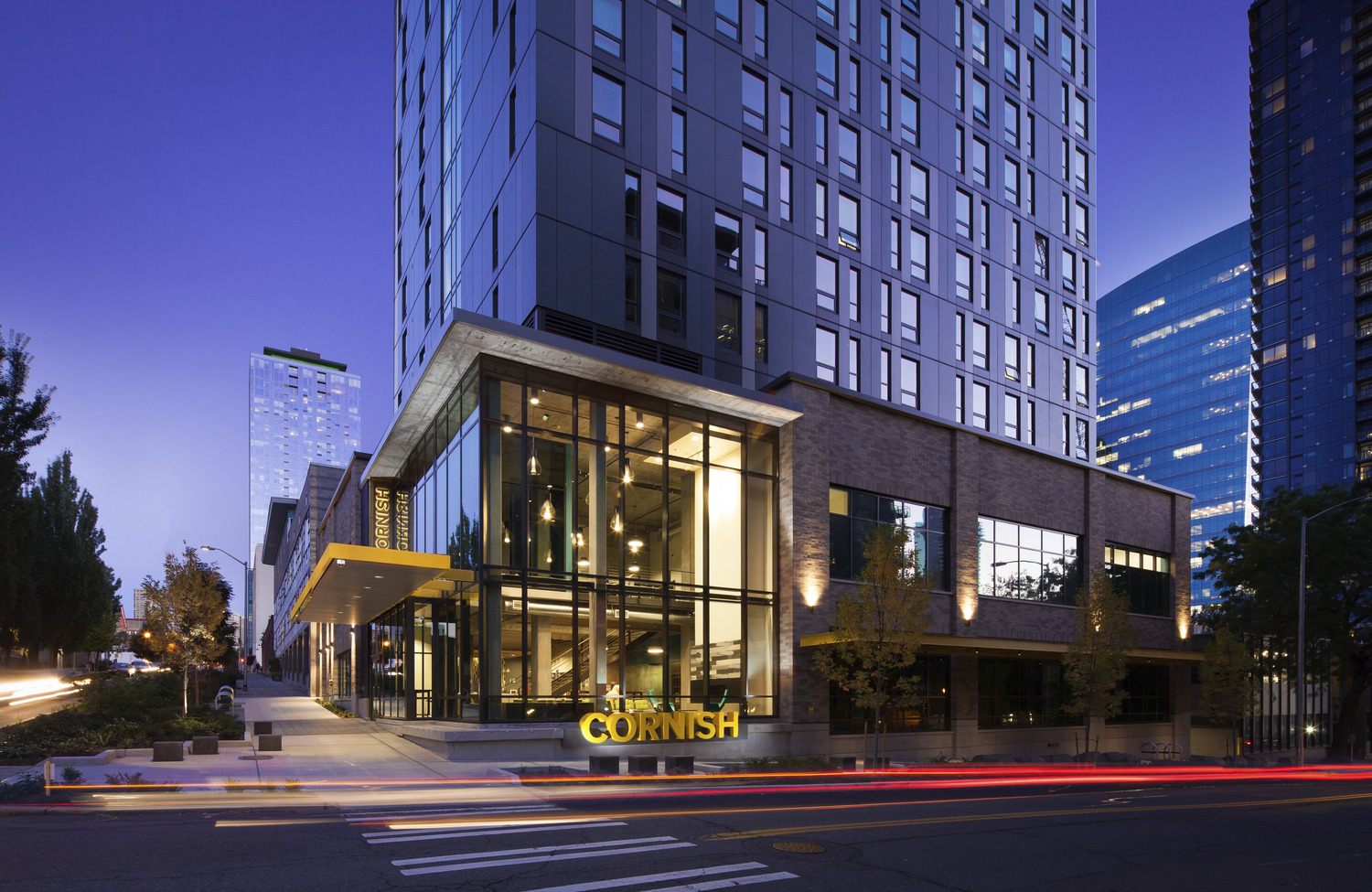
Cornish Commons
Want to get to know more of the Student Housing Team? Learn about Alissa Brandt and Matt Janssen here.
Get to Know Our Student Housing Leaders
Two of our Student Housing studio leaders, Alissa Brandt and Matt Janssen, give us insight into the unique joys and challenges of designing student housing. They touch on Gen Z expectations, trend forecasting, sources of inspiration and what’s next for student housing.

Alissa Brandt, Interior Designer, VP of Interiors
Q: What do you like best about designing student housing?
A: This particular market is always evolving based on what is happening in the world and how these influences affect them personally. The research is fascinating; students’ wants and needs are highly reflective of the current economic trends, environmental challenges, and social justice structure of their communities. They are pushing back on the status quo and are committed to making a difference for themselves and for others. They demand sustainability, are financially savvy and want real authentic design, not products that mimic the real thing and they are so open–minded and fluid.
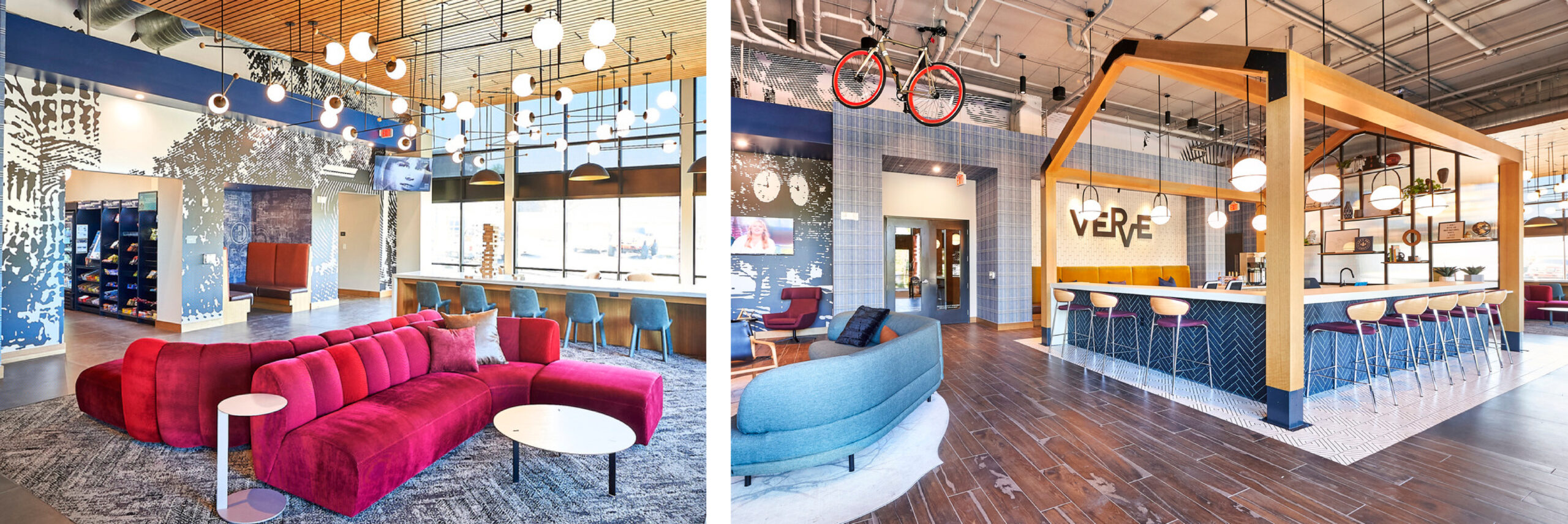
Verve Bloomington
Q: What’s something that has you excited about future work in this sector? What trends are you seeing?
A: Design remains on the cusp of what is next. Gen Z doesn’t want what everyone else has, they want what comes next. They are clever and creative and so multi-experiential.Designing for Gen Z requires you to consider all of the possible ways different people may do the same thing and tailor a design to allow each person to embrace spaces as their own. It is about creating opportunities for connection, engaged active behavior, solo thoughtful work, and everything in between for EACH person. One size does not fit all, and their lifestyles require flexibility be built into their environment. Wellness is a major consideration in designing for Gen Z. This generation prioritizes the need to take care of themselves, they crave access to nature, and they think about their health holistically not just physical wellness, but emotional, spiritual, and psychological well-being are all equally important.
Q: What’s uniquely challenging about designing student housing?
A: The obvious answer is timing. Everything revolves around the opening date. You simply don’t have any flexibly in delivering this product as students have signed contracts and school is starting, but that is more logistics and process.
The more interesting challenges are understanding what students wants are specific to the University location. What drew them to this particular college/university? You have to dig in, research, and understand the regional and local context in order to find ways to celebrate those, while also being mindful to not over commit to this as a concept as not everyone finds the same idea appealing.
The other fun challenge is staying relevant and up to date on trends, what does the demographic want and expect right now? And even more important, anticipating how these desires will morph over the next 2-3 years while the project is in design and construction. There is a delicate balance between being trendy and being relevant. That is the job of the designer to decipher and implement and anticipate the future needs and wants of the residents.
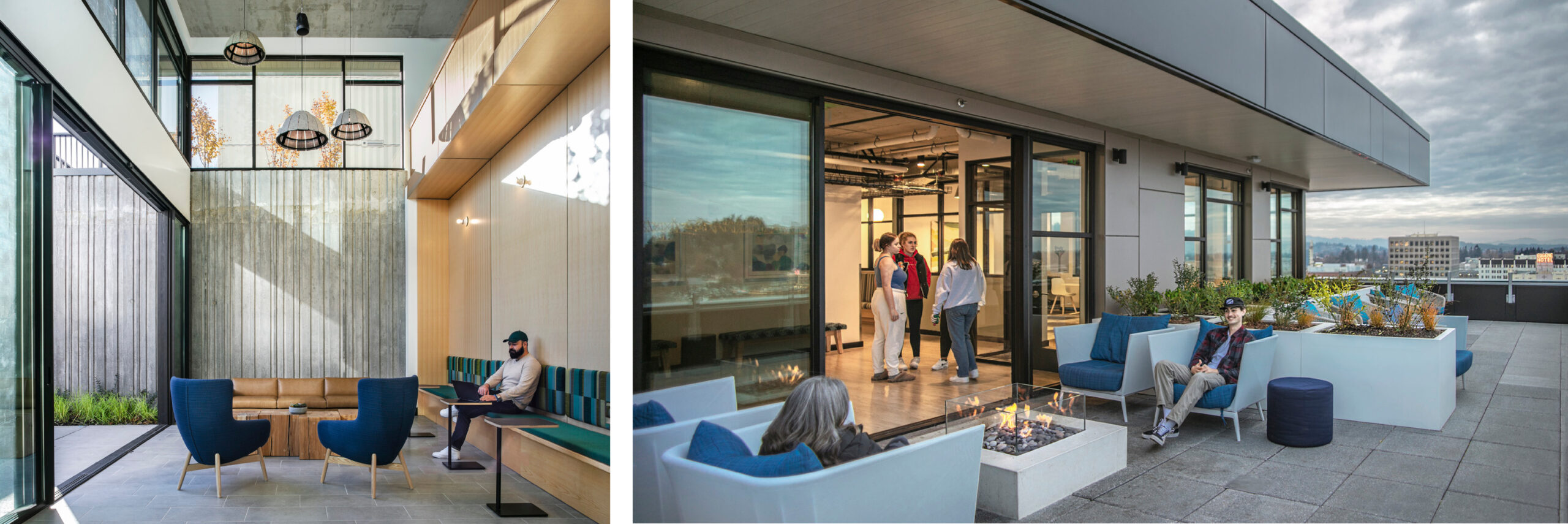
Union on Broadway
Q: What inspires you?
A: Creating spaces where students begin the next phase of their life. This is the first time many are away from home, family and friends and there is uncertainty but there is also tremendous excitement around what the future might bring and what opportunities they will find. Many will have experiences that they look back on for many years. This time in their lives shapes who they become. They develop lifelong friendships and find their own voice. It is really important to me that the design we provide elevates the experience these students have. Connection to the community, the university and to each other are so important to having a successful experience and we, as designers, have the opportunity to design these opportunities into these buildings. We research trends, demographics and psychographics so that we can provide spaces that are experiential, flexible and adaptable to the ever-changing needs of the residents. We get to consider all the types of people and personalities that will use the space and work to create design solutions that appeal to everyone. We always aim to create spaces that evoke emotion and feeling while also making them feel safe and secure.

Matt Janssen, Architect, Design Principal
Q: What do you like best about designing student housing?
A: Designing a building which becomes “home” for someone leaving their family for the first time, or living in their own apartment for the first time off campus, while they pursue an education which will change their life forever, is invigorating. It is exciting to imagine the effect a place or space you design will have on student success and on an overall campus community.
Q: What’s something that has you excited about future work in this sector? What trends are you seeing?
A: There are two areas which I am very excited about right now: the effect design can have on student wellness, both mental and physical, and the ability for design, and the design process, to open up and create an environment of community inclusion and a sense of belonging wherein all are heard, all are seen, and all are appreciated for who they are and what they bring to the table. The developments in green technologies, including mass timber systems and the inclusion of biophilia in student housing, is exciting especially when thinking about student wellness.
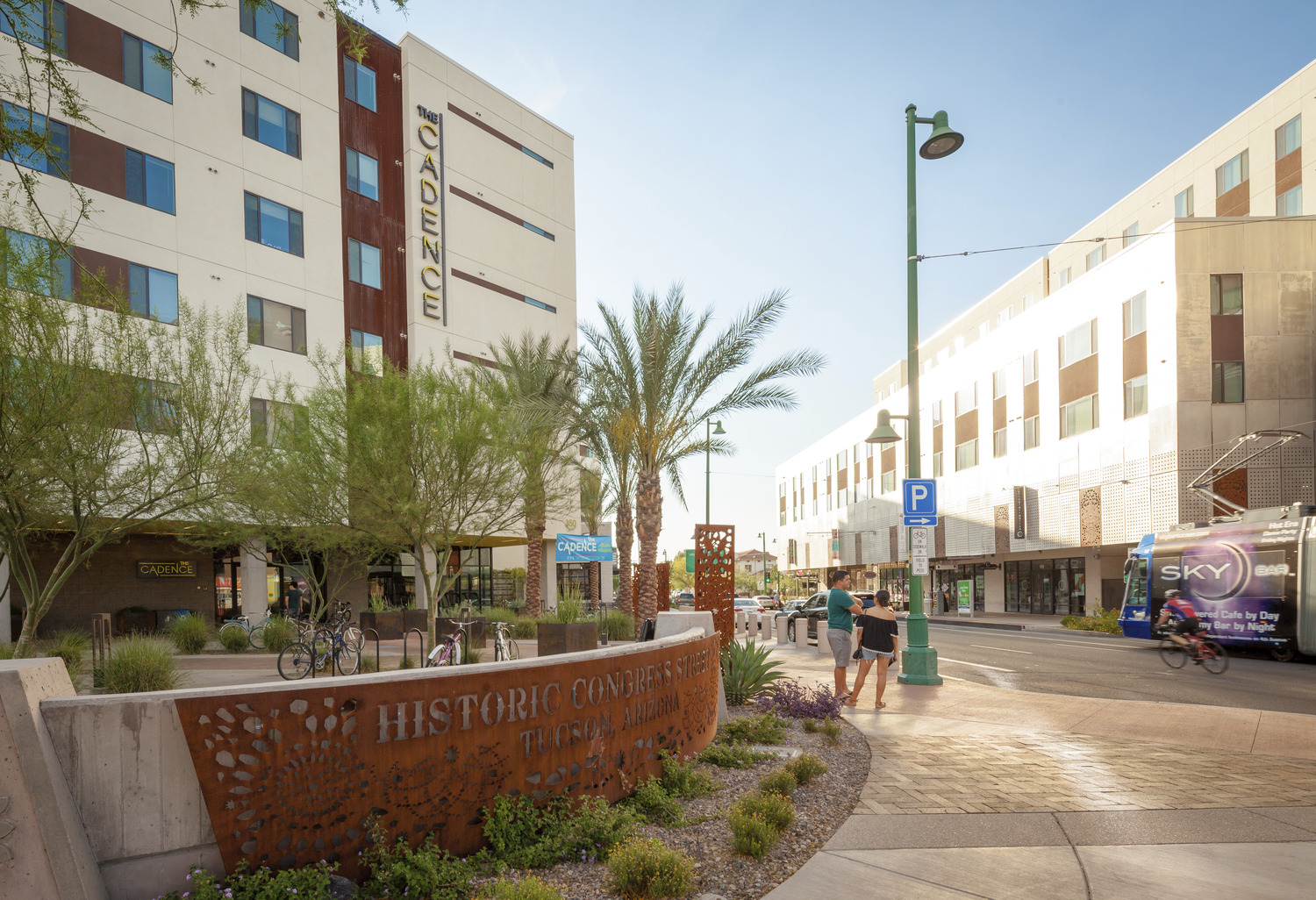
Cadence
Q: What’s a memorable moment from your career?
A: When the Cadence first opened, seeing the two buildings greet us coming into downtown Tucson surrounded by the new streetcar, bikes, and pedestrian activity, it was exciting to see the realization of everyone’s hard work to bring this vibrant, mixed-use, urban experience to this gateway location. That being said, the opportunity for my daughter to move into The Standard at Seattle this upcoming fall is going to be quite memorable. Having her live in a building I designed is both exciting and nerve-wracking.
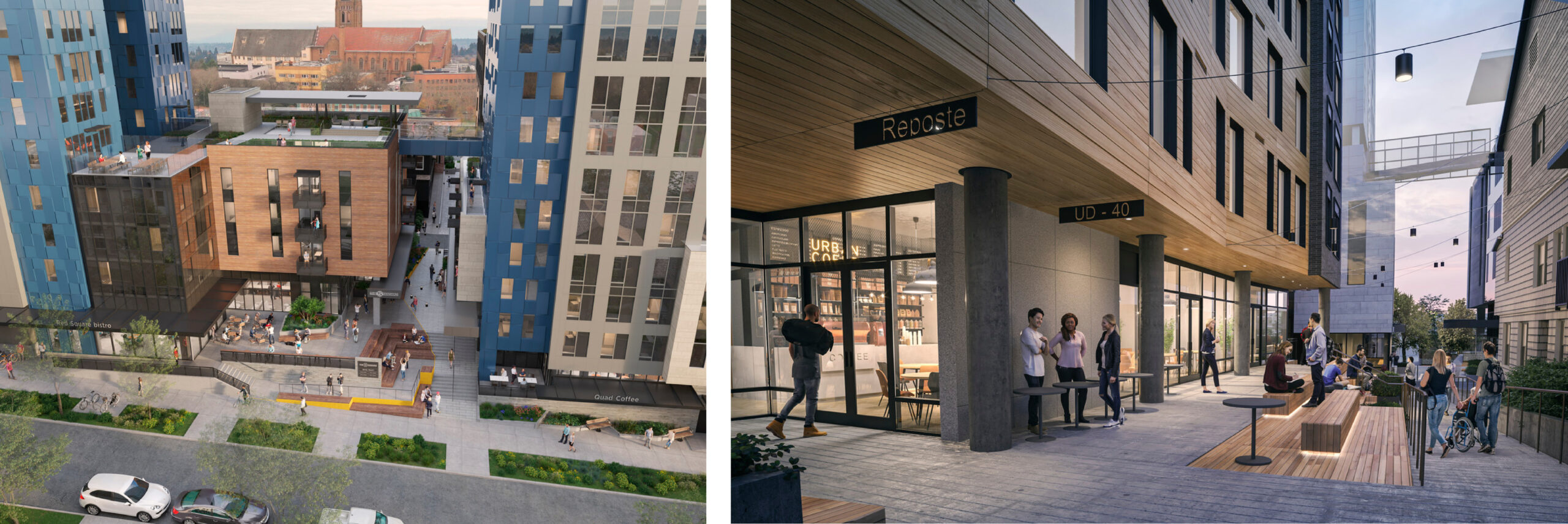
The Standard at Seattle
Q: What’s uniquely challenging about designing student housing?
A: Universities run on an annual schedule which does not change. As a result, projects must open on time and ready to go, typically by fall term. This creates an environment wherein decisions must be made quickly and efficiently. Being able to pivot, strategize, and problem solve when change happens is invigorating. Communicating with multiple stakeholders to understand everyone’s point of view, what their needs are, and how we can symbiotically mesh the various uses (residential, learning, offices, amenities, …) into a singular, holistic design which helps support student success is as rewarding as architecture gets for me.
Q: What interesting changes have you seen in this sector over the years?
A: It is exciting to see conversations of community and pedestrian activity be more of a topic of discussion rather than automobile parking. More and more, the design of alternative means of transportation in and around campuses, and how student housing ties into and supports those systems, will be critical now and in the coming years.
Vi Hilbert Hall at Seattle University
Want to get to know more of the Student Housing Team? Learn about Jason Jones and Cindy Schaumberg here.






